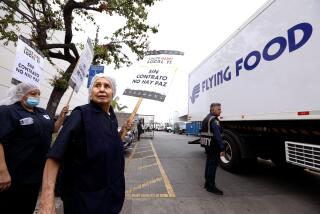Good News Still Scarce for the Unemployed
On the 50th anniversary last week of the creation of the nation’s unemployment benefits system, there was mostly bad news for jobless Americans.
And there isn’t even much good news for those who have lost their jobs and found new ones. Consider:
- The proportion of the nation’s jobless who are eligible to draw benefits is near an all-time low, in part because of strict eligibility rules imposed by the Reagan Administration and individual states.
- A steadily increasing number of economically “downwardly mobile” Americans are being forced either to take substantial pay cuts or to suffer prolonged periods of unemployment without benefits.
- The current jobless rate of 7.2% has stayed about the same for nearly six months. That is down from the 10.7% rate that it reached during the 1981-82 recession. But the bad news is that it has not dropped to the pre-recession level of less than 7%. In recent years, a sort of unemployment ratcheting effect has been occurring, with post-recession rates consistently higher than before the recessions began.
Congress created jobless benefits as part of the Social Security system on Aug. 14, 1935, when the unemployment rate was 20.1%. In fact, the massive Social Security system itself grew out of President Franklin D. Roosevelt’s plan to set up a program to help the jobless.
Neils Ruud, a Madison, Wis., photo engraver who had been earning $50 a week, drew the country’s first jobless benefit check in 1936. The initial payments were just $15 a week.
Since then, nearly 274 million Americans have received a total of more than $252 billion to help tide them over those bleak periods of unemployment.
That initial $15 weekly payment might seem low, but consider this: Accounting for inflation, that would be worth $116.50 today, and now the average weekly benefit is $120.
These days, however, benefits vary widely from state to state and according to what the workers were making before they lost their jobs.
The system’s goal is to provide benefits amounting to about 50% of regular weekly wages, although there are limits both on the actual and theoretical amount that a jobless worker can draw. Generally, benefits total about 37% of a worker’s average wage.
The effect of federal policies, along with actions by states to reduce the number of those who can draw unemployment benefits, has revived debates over methods used by the Bureau of Labor Statistics to count the unemployed.
Critics of the present system complain that the bureau’s monthly survey of 50,000 Americans is not adequate to determine the actual unemployment rate. In a study just released, the New York-based Council on International and Public Affairs says that, while the official BLS jobless rate for June was 7.3%, a more accurate estimate is 14.7%.
This would mean that the jobless rate is worse than in any comparable period of recovery from a recession in the last 20 years.
Dick Dembo, who coordinated the study, said the huge discrepancy results in part from the bureau’s decision to list as employed the rapidly growing number of those who work part time, even if just for an hour a week.
In addition, Dembo said that, while the BLS does keep track of the number of “discouraged workers” (those who would like to work but have given up finding a job and, at the time of the survey, are no longer considered part of the work force), it does not include them in its official unemployment rate. To be counted as unemployed, a worker must be actively seeking a job and must not have worked, however briefly, during the survey period.
The BLS report may not reflect the true depth of unemployment, but even its critics acknowledge that, because the system has been used for years, its figures accurately reflect monthly changes.
Another point of contention is the percentage of unemployed workers eligible for jobless benefits. The bureau says the figure is not at a record low. But critics say that, if workers employed only a few hours a week are included, the percentage getting benefits is, indeed, a record low.
According to the BLS, 29.3% of the 8.7 million Americans seeking work in July were able to draw unemployment benefits, just a fraction above the record low of about 28%. Normally, about 45% to 50% of the jobless receive benefits.
Among the 11 largest states, Texas and Florida reported that only 15% of their unemployed workers were drawing jobless benefits in July. At the top of the list was Massachusetts, where 45.7% were drawing benefits. California’s 37.3% was above the national average.
Intensifying the problems created by cutting off hundreds of thousands of unemployed from jobless benefits is what the new study by the Council on International and Public Affairs calls the “pauperization of work in America.”
The Department of Labor estimates that, in the past four years, nearly 1 million workers have taken pay cuts in their union contracts, making them part of the “pauperization” process. In addition, there are millions of other workers who have lost their jobs and have had to accept substantial cuts in income at new jobs.
The latest government study showing the size of the cuts taken by workers who had to find new jobs was made in January, 1984. A total of 11.4 million workers who lost their jobs during the recession were surveyed, but the study concentrated on 5.1 million workers who had at least three years on their old jobs.
The study showed that only 60% of those who had lost their jobs between the beginning of 1979 and the end of 1983 had found work by January, 1984, and that 45.7% of those were able to find only part-time or lower-paying jobs.
Of those who found work, 27% had new jobs that paid 80% or less of their previous wages. An additional 15% were earning at least somewhat less than they did in their old jobs.
Thus, the study indicates clearly that new jobs being created in such industries as health, services and retailing are paying lower wages than those jobs lost in manufacturing, substantiating the claim of “pauperization of work.” That, in turn, emphasizes what has been called the “feminization of poverty,” since most of the women entering the work force are employed in newly created, low-paying jobs.
Thus, while the nation properly celebrates the 50th anniversary of the jobless pay system, Congress should revamp the eligibility requirements to ensure that all of the unemployed who need help can get it.
CWA Prepares for IBM
The recent loudly heralded plan of the Communications Workers of America to try to unionize IBM represents one of the major problems facing unions today: Can they organize companies that have a reputation for treating workers fairly?
The answer, insists Morton Bahr, who was elected CWA president last month, is “yes, although we know, of course, that it is a long-range process.”
Bahr is operating on the theory that all workers need a union, and his strategy is to start the admittedly difficult task of organizing IBM’s 238,000 workers in the United States in small segments, beginning with newly acquired divisions that do not provide the same wages and conditions offered at such unionized companies as AT&T.;
One of the first targets will be MCI Communications, of which IBM recently agreed to buy as much as 30%.
MCI, Bahr says, has structured itself to conform with the geographical boundaries of the seven regional telephone companies that were affiliated with AT&T; before its breakup. He will meet next month with leaders of CWA locals in each of the seven regions, asking them to “adopt” an MCI division in their area.
In that way, he said, “the local union people will be talking with the non-union MCI employees as their neighbors, urging them to become members or at least associate members of our union.”
Associate membership is a new concept under consideration at the recommendation of AFL-CIO leadership, which is trying to deal with declining membership. Such members would receive newsletters to keep them informed of wages and conditions at unionized firms. They would also be eligible for some benefits provided by the union, ranging from low-cost insurance to discounts on vacation trips.
In time, he predicts, the associate members will become full members with union contracts.
By localizing union organizing, Bahr said, the company will not be able to label CWA organizers as “outsiders or carpetbaggers coming into a community as strangers.”
The initial campaign will concentrate on MCI because it competes directly with AT&T.; Obviously, Bahr said, “if MCI pays lower wages and provides fewer benefits than AT&T;, in time AT&T; will try to cut its labor costs down to the level of MCI.”
A similar strategy will be used at Rolm, another non-union company that was bought by IBM last September. Rolm makes telephone equipment and competes with unionized equipment manufacturers.
In addition, on Sept. 15, CWA leaders will meet in Interlaken, Switzerland, with union leaders from more than 120 other countries where IBM employs 150,000 mostly non-union workers. They will discuss ways of unionizing IBM facilities around the world.
The goal, Bahr said, is “to eliminate labor costs as a significant factor in the competition between companies in the communications industry, and we can only do that if the companies are unionized.”
That competition has already resulted in some layoffs in the industry, including those of thousands of AT&T; employees, and more are expected. Bahr says unionized employers, including AT&T;, are encouraging the Communications Workers to organize the non-union competitors.
Walter Murphy, AT&T;’s director of corporate information, said the giant firm is not “suggesting to the union which companies, if any, they should try to organize.” However, he said, it is obviously difficult to argue with Bahr’s reasoning that lower labor costs paid by non-union competitors might have a negative effect on workers’ contracts with AT&T.;
More to Read
Inside the business of entertainment
The Wide Shot brings you news, analysis and insights on everything from streaming wars to production — and what it all means for the future.
You may occasionally receive promotional content from the Los Angeles Times.










